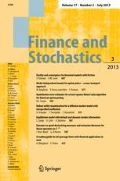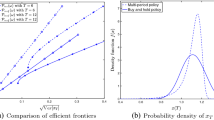Abstract
It is well known that mean-variance portfolio selection is a time-inconsistent optimal control problem in the sense that it does not satisfy Bellman’s optimality principle and therefore the usual dynamic programming approach fails. We develop a time-consistent formulation of this problem, which is based on a local notion of optimality called local mean-variance efficiency, in a general semimartingale setting. We start in discrete time, where the formulation is straightforward, and then find the natural extension to continuous time. This complements and generalises the formulation by Basak and Chabakauri (2010) and the corresponding example in Björk and Murgoci (2010), where the treatment and the notion of optimality rely on an underlying Markovian framework. We justify the continuous-time formulation by showing that it coincides with the continuous-time limit of the discrete-time formulation. The proof of this convergence is based on a global description of the locally optimal strategy in terms of the structure condition and the Föllmer–Schweizer decomposition of the mean-variance trade-off. As a by-product, this also gives new convergence results for the Föllmer–Schweizer decomposition, i.e., for locally risk-minimising strategies.
Similar content being viewed by others
References
Albert, A.: Regression and the Moore–Penrose Pseudoinverse. Mathematics in Science and Engineering. Academic Press, San Diego (1972)
Basak, S., Chabakauri, G.: Dynamic mean-variance asset allocation. Rev. Financ. Stud. 23, 2970–3016 (2010)
Björk, T., Murgoci, A.: A general theory of Markovian time inconsistent stochastic control problems. Preprint, Stockholm School of Economics, September 2010. http://ssrn.com/abstract=1694759
Björk, T., Murgoci, A., Zhou, X.Y.: Mean variance portfolio optimization with state dependent risk aversion. Math. Finance (to appear). Available at http://onlinelibrary.wiley.com/doi/10.1111/j.1467-9965.2011.00515.x/pdf
Bouchard, B., Elie, R., Touzi, N.: Discrete-time approximation of BSDEs and probabilistic schemes for fully nonlinear PDEs. In: Albrecher, H., Runggaldier, W., Schachermayer, W. (eds.) Advanced Financial Modelling. Radon Ser. Comput. Appl. Math., vol. 8, pp. 91–124. Walter de Gruyter, Berlin (2009)
Briand, P., Delyon, B., Mémin, J.: Donsker-type theorem for BSDEs. Electron. Commun. Probab. 6, 1–14 (2001) (electronic)
Briand, P., Delyon, B., Mémin, J.: On the robustness of backward stochastic differential equations. Stoch. Process. Appl. 97, 229–253 (2002)
Campbell, J., Viceira, L.: Strategic Asset Allocation: Portfolio Choice for Long-Term Investors. Oxford University Press, London (2002)
Choulli, T., Krawczyk, L., Stricker, C.: \(\mathcal{E}\)-martingales and their applications in mathematical finance. Ann. Probab. 26, 853–876 (1998)
Choulli, T., Stricker, C.: Deux applications de la décomposition de Galtchouk–Kunita–Watanabe. In: Azéma, J., Yor, M., Emery, M. (eds.) Séminaire de Probabilités, XXX. Lecture Notes in Math., vol. 1626, pp. 12–23. Springer, Berlin (1996)
Choulli, T., Vandaele, N., Vanmaele, M.: The Föllmer–Schweizer decomposition: Comparison and description. Stoch. Process. Appl. 120, 853–872 (2010)
Cui, X., Li, D., Wang, S., Zhu, S.: Better than dynamic mean-variance: time inconsistency and free cash flow stream. Math. Finance 22, 346–378 (2012)
Czichowsky, C., Schweizer, M.: Cone-constrained continuous-time Markovitz problems. NCCR FINRISK working paper No. 683, ETH Zurich, June 2012. To appear in Annals of Applied Probability, available at http://www.nccr-finrisk.uzh.ch/wps.php?action=query&id=683
Czichowsky, C., Schweizer, M.: Closedness in the semimartingale topology for spaces of stochastic integrals with constrained portfolios. In: Donati-Martin, C., Lejay, A., Rouault, A. (eds.) Séminaire de Probabilités XLIII. Lecture Notes in Math., vol. 2006, pp. 413–436. Springer, Berlin (2011)
Delbaen, F., Monat, P., Schachermayer, W., Schweizer, M., Stricker, C.: Weighted norm inequalities and hedging in incomplete markets. Finance Stoch. 1, 181–227 (1997)
Delbaen, F., Schachermayer, W.: The existence of absolutely continuous local martingale measures. Ann. Appl. Probab. 5, 926–945 (1995)
Delbaen, F., Schachermayer, W.: The Mathematics of Arbitrage. Springer Finance. Springer, Berlin (2006)
Dellacherie, C., Meyer, P.A.: Probabilities and Potential B. Theory of Martingales. North-Holland, Amsterdam (1982)
Ekeland, I., Lazrak, A.: Being serious about non-commitment: subgame perfect equilibrium in continuous time, Apr. 2006. http://arxiv.org/abs/math/0604264v1
Ekeland, I., Lazrak, A.: Equilibrium policies when preferences are time inconsistent, Aug. 2008. http://arxiv.org/abs/0808.3790v1
Ekeland, I., Pirvu, T.A.: Investment and consumption without commitment. Math. Financ. Econ. 2, 57–86 (2008)
Ekeland, I., Pirvu, T.A.: On a non-standard stochastic control problem, June 2008. http://arxiv.org/abs/0806.4026v1
Emery, M.: Compensation de processus à variation finie non localement intégrables. In: Azéma, J., Yor, M. (eds.) Séminaire de Probabilités, XIV. Lecture Notes in Math., vol. 784, pp. 152–160. Springer, Berlin (1980)
Fleming, W.H., Soner, H.M.: Controlled Markov Processes and Viscosity Solutions, 2nd edn. Stochastic Modelling and Applied Probability, vol. 25, Springer, New York (2006)
Föllmer, H., Schweizer, M.: The minimal martingale measure. In: Cont, R. (ed.) Encyclopedia of Quantitative Finance, pp. 1200–1204. Wiley, New York (2010)
Jacod, J., Méléard, S., Protter, P.: Explicit form and robustness of martingale representations. Ann. Probab. 28, 1747–1780 (2000)
Jacod, J., Shiryaev, A.N.: Limit Theorems for Stochastic Processes, 2nd edn. Grundlehren der Mathematischen Wissenschaften, vol. 288. Springer, Berlin (2003)
Kallsen, J.: A utility maximization approach to hedging in incomplete markets. Math. Methods Oper. Res. 50, 321–338 (1999)
Kallsen, J.: Derivative pricing based on local utility maximization. Finance Stoch. 6, 115–140 (2002)
Kallsen, J.: σ-localization and σ-martingales. Theory Probab. Appl. 48, 152–163 (2004)
Kardaras, C., Platen, E.: Multiplicative approximation of wealth processes involving no-short-sale strategies via simple trading. Math. Finance (2012, to appear). Available at http://onlinelibrary.wiley.com/doi/10.1111/j.1467-9965.2011.00511.x/pdf
Li, D., Ng, W.-L.: Optimal dynamic portfolio selection: multiperiod mean-variance formulation. Math. Finance 10, 387–406 (2000)
Maccheroni, F., Marinacci, M., Rustichini, A., Taboga, M.: Portfolio selection with monotone mean-variance preferences. Math. Finance 19, 487–521 (2009)
Markowitz, H.: Portfolio selection. J. Finance 7, 77–91 (1952)
Monat, P., Stricker, C.: Föllmer–Schweizer decomposition and mean-variance hedging for general claims. Ann. Probab. 23, 605–628 (1995)
Mossin, J.: Optimal multiperiod portfolio policies. J. Bus. 41, 215–229 (1968)
Musiela, M., Zariphopoulou, T.: Investments and forward utilities. Technical report (2006). Available at http://www.oxford-man.ox.ac.uk/~zariphop/pdfs/tz-technicalreport-4.pdf
Musiela, M., Zariphopoulou, T.: The backward and forward dynamic utilities and their associated pricing systems: the case study of the binomial model. Technical report (2003). Available at http://www.math.utexas.edu/users/zariphop/pdfs/tz-technicalreport-7.pdf
Nutz, M.: The Bellman equation for power utility maximization with semimartingales. Ann. Appl. Probab. 22, 363–406 (2012)
Pham, H., Rheinländer, T., Schweizer, M.: Mean-variance hedging for continuous processes: new proofs and examples. Finance Stoch. 2, 173–198 (1998)
Protter, P.E.: Stochastic Integration and Differential Equations, 2nd edn. Stochastic Modelling and Applied Probability, vol. 21. Springer, Berlin (2005). Version 1
Richardson, H.R.: A minimum variance result in continuous trading portfolio optimization. Manag. Sci. 35, 1045–1055 (1989)
Schweizer, M.: Hedging of options in a general semimartingale model. Diss. ETH Zürich 8615 (1988)
Schweizer, M.: Approximating random variables by stochastic integrals. Ann. Probab. 22, 1536–1575 (1994)
Schweizer, M.: On the minimal martingale measure and the Föllmer–Schweizer decomposition. Stoch. Anal. Appl. 13, 573–599 (1995)
Schweizer, M.: A guided tour through quadratic hedging approaches. In: Jouini, É., Cvitanić, J., Musiela, M. (eds.) Option Pricing, Interest Rates and Risk Management. Handb. Math. Finance, pp. 538–574. Cambridge University Press, Cambridge (2001)
Schweizer, M.: Local risk-minimization for multidimensional assets and payment streams. In: Stettner, Ł. (ed.) Advances in Mathematics of Finance. Banach Center Publ., vol. 83, pp. 213–229. Polish Acad. Sci. Inst. Math., Warsaw (2008)
Schweizer, M.: Mean-variance hedging. In: Cont, R. (ed.) Encyclopedia of Quantitative Finance, pp. 1177–1181. Wiley, New York (2010)
Strotz, R.: Myopia and inconsistency in dynamic utility maximization. Rev. Econ. Stud. 23, 165–180 (1956)
Sun, W.G., Wang, C.F.: The mean-variance investment problem in a constrained financial market. J. Math. Econ. 42, 885–895 (2006)
Acknowledgements
The author thanks Tahir Choulli, Michael Kupper and Martin Schweizer for discussions and Wolfgang Runggaldier, Martin Schweizer and two anonymous referees for careful reading and helpful suggestions. Financial support by the National Centre of Competence in Research “Financial Valuation and Risk Management” (NCCR FINRISK), Project D1 (Mathematical Methods in Financial Risk Management) is gratefully acknowledged. The NCCR FINRISK is a research instrument of the Swiss National Science Foundation.
Author information
Authors and Affiliations
Corresponding author
Appendix: Representative square-integrable portfolios
Appendix: Representative square-integrable portfolios
In this appendix, we show the existence of representative square-integrable portfolios as announced in Sect. 2. As stated in Lemma A.1 below, these are square-integrable strategies φ
i∈Θ
S
for i=1,…,d that are representative in the sense that the financial market \((\widetilde{S}, \varTheta_{\widetilde{S}})\) with  for i=1,…,d generates the same family of wealth processes as the financial market (S,Θ
S
), i.e.,
for i=1,…,d generates the same family of wealth processes as the financial market (S,Θ
S
), i.e.,  . For this we use the notion of σ-square-integrability. A semimartingale X is σ-square-integrable, which we denote by \(X\in\mathcal{H}^{2}_{\sigma }(P)\), if there exists an increasing sequence (D
n
) of predictable sets such that D
n
↑Ω×[0,T] and
. For this we use the notion of σ-square-integrability. A semimartingale X is σ-square-integrable, which we denote by \(X\in\mathcal{H}^{2}_{\sigma }(P)\), if there exists an increasing sequence (D
n
) of predictable sets such that D
n
↑Ω×[0,T] and  for each n; see [30] for the concept of σ-localisation. If there exists a sequence of stopping times (σ
n
) such that we can choose \(D_{n}=[\mskip-2mu[0,\sigma_{n}]\mskip-2mu]\) for each n∈ℕ, the concept of σ-square-integrability coincides with the classical notion of local square-integrability. The latter is for example always the case if S is continuous. The basic idea for the proof is then the following. Even though square-integrability is a global property of the strategy ϑ, it implies that ϑ is σ-square-integrable, i.e.,
for each n; see [30] for the concept of σ-localisation. If there exists a sequence of stopping times (σ
n
) such that we can choose \(D_{n}=[\mskip-2mu[0,\sigma_{n}]\mskip-2mu]\) for each n∈ℕ, the concept of σ-square-integrability coincides with the classical notion of local square-integrability. The latter is for example always the case if S is continuous. The basic idea for the proof is then the following. Even though square-integrability is a global property of the strategy ϑ, it implies that ϑ is σ-square-integrable, i.e.,  , which can be characterised (ω,t)-pointwise. Since there exists a one-to-one correspondence between σ-square-integrable and square-integrable integrands by Proposition 2 in [23] (see below), the (ω,t)-pointwise characterisation of σ-square-integrability is sufficient to find the representative square-integrable portfolios. To derive this characterisation, we need to work with the notion of predictable characteristics which we introduce next.
, which can be characterised (ω,t)-pointwise. Since there exists a one-to-one correspondence between σ-square-integrable and square-integrable integrands by Proposition 2 in [23] (see below), the (ω,t)-pointwise characterisation of σ-square-integrability is sufficient to find the representative square-integrable portfolios. To derive this characterisation, we need to work with the notion of predictable characteristics which we introduce next.
As in Theorem II.2.34 in [27], each semimartingale S has the canonical representation

with the jump measure μ of S and its predictable compensator ν. Then the quadruple (b,c,F,B) of predictable characteristics of S consists of a predictable ℝd-valued process b, a predictable nonnegative-definite symmetric matrix-valued process c, a predictable process F with values in the set of Lévy measures on ℝd, and a predictable nondecreasing process B null at zero such that

Using this local description of the semimartingale S, we can prove the existence of representative square-integrable portfolios.
Lemma A.1
There exist square-integrable strategies
φ
i∈Θ
S
for
i=1,…,d
such that the financial markets (S,Θ
S
) and
\((\widetilde{S},\varTheta_{\widetilde{S}})\)
with
 for
i=1,…,d
admit the same families of wealth processes, i.e.,
for
i=1,…,d
admit the same families of wealth processes, i.e.,  .
.
Proof
By Proposition 2 in [23] (and the paragraph preceding that), σ-square-integrability of a semimartingale X is equivalent to the existence of a strictly positive, bounded predictable process ψ such that  . As ψ is bounded and strictly positive, we can therefore always switch back and forth between σ-square- integrable X and square-integrable semimartingales Y by using the associativity of the stochastic integral, i.e.,
. As ψ is bounded and strictly positive, we can therefore always switch back and forth between σ-square- integrable X and square-integrable semimartingales Y by using the associativity of the stochastic integral, i.e.,  and
and  . Moreover, this also allows to reduce our problem to σ-square-integrability, which we consider first. Like any semimartingale, a stochastic integral
. Moreover, this also allows to reduce our problem to σ-square-integrability, which we consider first. Like any semimartingale, a stochastic integral  of an S-integrable process ϑ is σ-square-integrable if and only if the sum \(Z:=\sum_{0<s\leq\cdot}(\vartheta_{s}^{\top}\Delta S_{s})^{2}\) of its squared jumps is σ-integrable, i.e., there exists an increasing sequence (D
n
) of predictable sets such that D
n
↑Ω×[0,T] and
of an S-integrable process ϑ is σ-square-integrable if and only if the sum \(Z:=\sum_{0<s\leq\cdot}(\vartheta_{s}^{\top}\Delta S_{s})^{2}\) of its squared jumps is σ-integrable, i.e., there exists an increasing sequence (D
n
) of predictable sets such that D
n
↑Ω×[0,T] and  has integrable total variation \(\int_{0}^{T}|dZ^{n}_{s}|\) for each n. By Theorem II.1.8 in [27], the latter condition is equivalent to the process \(\int_{0}^{\cdot}\int_{\mathbb{R}^{d}}(\vartheta_{s}^{\top}{x})^{2}F_{s}(dx)\,dB_{s}\) being σ-integrable, which holds if and only if \(\int_{\mathbb{R}^{d}}(\vartheta_{s}^{\top}{x})^{2}F_{s}(dx)<+\infty\)
P
B
-a.e. If S is one-dimensional, i.e., d=1, we can write \(\vartheta_{s}^{2}\int_{\mathbb{R}^{d}}x^{2}F_{s}(dx)=\int_{\mathbb {R}^{d}}(\vartheta_{s}^{\top}{x})^{2}F_{s}(dx)<+\infty \)
P
B
-a.e., which basically tells us that we must have ϑ=0 P
B
-a.e. on the set \(D^{c}:=\{\int_{\mathbb{R}^{d}}x^{2}F(dx)=+\infty\}\in\mathcal{P}\). Therefore setting
has integrable total variation \(\int_{0}^{T}|dZ^{n}_{s}|\) for each n. By Theorem II.1.8 in [27], the latter condition is equivalent to the process \(\int_{0}^{\cdot}\int_{\mathbb{R}^{d}}(\vartheta_{s}^{\top}{x})^{2}F_{s}(dx)\,dB_{s}\) being σ-integrable, which holds if and only if \(\int_{\mathbb{R}^{d}}(\vartheta_{s}^{\top}{x})^{2}F_{s}(dx)<+\infty\)
P
B
-a.e. If S is one-dimensional, i.e., d=1, we can write \(\vartheta_{s}^{2}\int_{\mathbb{R}^{d}}x^{2}F_{s}(dx)=\int_{\mathbb {R}^{d}}(\vartheta_{s}^{\top}{x})^{2}F_{s}(dx)<+\infty \)
P
B
-a.e., which basically tells us that we must have ϑ=0 P
B
-a.e. on the set \(D^{c}:=\{\int_{\mathbb{R}^{d}}x^{2}F(dx)=+\infty\}\in\mathcal{P}\). Therefore setting  , where ψ is the integrand from Proposition 2 in [23] for the σ-square-integrable semimartingale
, where ψ is the integrand from Proposition 2 in [23] for the σ-square-integrable semimartingale  , gives the desired strategy.
, gives the desired strategy.
In the multidimensional case, the situation is more involved due to the linear dependence between the different components of S. To deal with this issue, we use similar techniques as in [14], where we also send the reader for more explanations on problems arising from this. For the rest of the proof, we consider integrands ϑ∈L(S) as elements of \(L^{0}(\varOmega\times[0,T],\mathcal{P},P_{B};\mathbb {R}^{d})\) and define the linear subspace V by
By definition, V satisfies the stability property that  for all ϑ
1,ϑ
2∈V and \(D\in\mathcal{P}\), and it is closed with respect to convergence in P
B
-measure by Fatou’s lemma. So there exist by Lemma 6.2.1 in [17] (see also Lemma 5.2 in [14]) v
i∈V for i=1,…,d such that
for all ϑ
1,ϑ
2∈V and \(D\in\mathcal{P}\), and it is closed with respect to convergence in P
B
-measure by Fatou’s lemma. So there exist by Lemma 6.2.1 in [17] (see also Lemma 5.2 in [14]) v
i∈V for i=1,…,d such that
-
(1)
{v i+1≠0}⊆{v i≠0} for i=1,…,d−1,
-
(2)
|v i(ω,t)|=1 or |v i(ω,t)|=0,
-
(3)
(v i)⊤ v k=0 for i≠k,
-
(4)
ϑ∈V if and only if \(\vartheta=\sum_{i=1}^{d} (\vartheta^{\top}{v}^{i}) v^{i}\) P B -a.e.
Since v
i is in V and bounded according to (2), we have that v
i∈L(S) and  is σ-square-integrable for i=1,…,d. By Proposition 2 in [23], there exist strictly positive, bounded predictable processes ψ
i such that
is σ-square-integrable for i=1,…,d. By Proposition 2 in [23], there exist strictly positive, bounded predictable processes ψ
i such that  for i=1,…,d, and we set φ
i=ψ
i
v
i and
for i=1,…,d, and we set φ
i=ψ
i
v
i and  . Since we can write each ϑ∈Θ
S
⊆V as \(\vartheta=\sum_{i=1}^{d} (\vartheta^{\top}{v}^{i}) v^{i}=\sum_{i=1}^{d} \frac{(\vartheta^{\top}{v}^{i})}{\psi^{i}} \varphi^{i}\)
P
B
-a.e. by (4), this gives \(\widetilde{\vartheta}=(\frac{(\vartheta^{\top}{v}^{1})}{\psi^{1}},\ldots,\frac {(\vartheta^{\top}{v}^{d})}{\psi^{d}})=:\varPsi\vartheta\in\varTheta_{\widetilde{S}}\), where \(\varPsi:= (\frac{v^{1}}{\psi^{1}},\ldots,\frac{v^{d}}{\psi^{d}} )^{\top}\) is a predictable ℝd×d-valued process, and that
. Since we can write each ϑ∈Θ
S
⊆V as \(\vartheta=\sum_{i=1}^{d} (\vartheta^{\top}{v}^{i}) v^{i}=\sum_{i=1}^{d} \frac{(\vartheta^{\top}{v}^{i})}{\psi^{i}} \varphi^{i}\)
P
B
-a.e. by (4), this gives \(\widetilde{\vartheta}=(\frac{(\vartheta^{\top}{v}^{1})}{\psi^{1}},\ldots,\frac {(\vartheta^{\top}{v}^{d})}{\psi^{d}})=:\varPsi\vartheta\in\varTheta_{\widetilde{S}}\), where \(\varPsi:= (\frac{v^{1}}{\psi^{1}},\ldots,\frac{v^{d}}{\psi^{d}} )^{\top}\) is a predictable ℝd×d-valued process, and that  by the associativity of the stochastic integral. Conversely, we have for each \(\widetilde{\vartheta}\in\varTheta_{\widetilde{S}}\) that \(\vartheta=\sum_{i=1}^{d} \widetilde{\vartheta}^{i} \varphi^{i}=\varPhi\widetilde{\vartheta}\in\varTheta_{S}\) with
by the associativity of the stochastic integral. Conversely, we have for each \(\widetilde{\vartheta}\in\varTheta_{\widetilde{S}}\) that \(\vartheta=\sum_{i=1}^{d} \widetilde{\vartheta}^{i} \varphi^{i}=\varPhi\widetilde{\vartheta}\in\varTheta_{S}\) with  , where Φ:=(φ
1,…,φ
d) is an ℝd×d-valued predictable process, which allows us to conclude that
, where Φ:=(φ
1,…,φ
d) is an ℝd×d-valued predictable process, which allows us to conclude that  and this completes the proof. □
and this completes the proof. □
Remark A.2
As an alternative to the proof above one can introduce a predictable correspondence C by
for all (ω,t)∈Ω×[0,T]. Then the condition ϑ∈V can be formulated as the pointwise constraint that ϑ(ω,t)∈C(ω,t) P B -a.e. As the values of C are linear subspaces, one can deduce the existence of representative σ-square-integrable portfolios by using (the arguments in the proof of) Theorem B.3 in Nutz [39]. The correspondence of the transformed constraints \(\widetilde{C}\) is then of course equal to ℝd for all (ω,t)∈Ω×[0,T] and the representative σ-square-integrable portfolios are the representative portfolios.
Rights and permissions
About this article
Cite this article
Czichowsky, C. Time-consistent mean-variance portfolio selection in discrete and continuous time. Finance Stoch 17, 227–271 (2013). https://doi.org/10.1007/s00780-012-0189-9
Received:
Accepted:
Published:
Issue Date:
DOI: https://doi.org/10.1007/s00780-012-0189-9
Keywords
- Mean-variance criterion
- Markowitz problem
- Portfolio optimisation
- Time consistency
- Time-inconsistent optimal control
- Local risk minimisation
- Föllmer–Schweizer decomposition
- Convergence of optimal trading strategies




